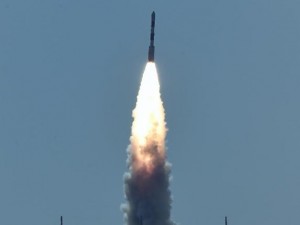ISRO’s Rocket Launched With 8 Satellites
NEW DELHI: In its longest and most complex mission till date, the Indian space agency ISRO today launched eight satellites from one rocket into two different orbits.
The 37th Polar Satellite Launch Vehicle or PSLV, carrying eight satellites – three from India, three from Algeria, and one each from Canada and the US – successfully lifted off from Sriharikota in Andhra Pradesh at 9:12 am.
What makes this launch challenging is that most countries launch satellites in a single orbit. Even if multiple satellites are injected, it is in a sequential manner in the same orbit. The twin-orbit manoeuvre was recently accomplished by European Space Agency’s Vega rocket.
Exactly 17 minutes into the launch, the PSLV will drop off the Indian weather satellite SCATSAT at an altitude of 730 km. After this, the seven remaining satellites will be dropped at a height of 689 km.
The mission will also test PSLV’s multiple burn capability which will be utilized in the last leg and will set a new milestone for ISRO. The whole procedure is expected to be completed within 2 hours and 15 minutes – the longest mission undertaken by ISRO.
The stop-start of the rocket – while travelling at a speed of more than 2660 kmph – positions PSLV as a unique launcher in the multi-billion dollar commercial launch market. “It will open up new vistas to commercialise ISRO’s launch capabilities for two-orbit configurations,” said Dr K Sivan, Director of the Vikram Sarabhai Space Center.
The three Indian satellites include the earth-observing satellite SCATSAT-1 and two others made by students to give them a hands-on experience in space technology.
The SCATSAT, costing around Rs. 120 crore, will help weather scientists forecast the formation of cyclones and monitor their land fall. India shares such data with the US, which helped them track Hurricane Sandy in 2012.
Pratham, a 10-kg satellite developed by students of the Indian Institute of Technology in Bombay, will study the total electron count in space. The 5.25-kg PISAT made by students of Bengaluru’s PES University will take pictures of earth.
In another first later this year, India hopes to launch its heaviest rocket, the Geo-Synchronous Satellite Launch Vehicle Mark III, capable of taking up to 4 tonnes of communications satellite.
Kindly send reply or comments on this topic to [email protected]
Source:Ndtv




